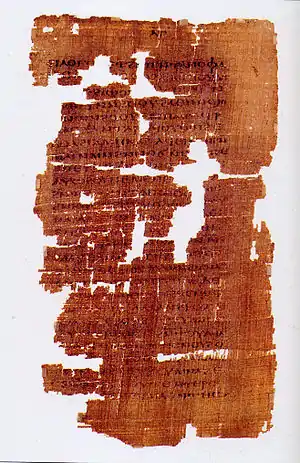Gnostic Apocalypse of Peter
The Gnostic Apocalypse of Peter is a text found amongst the Nag Hammadi library, and part of the New Testament apocrypha. Like the vast majority of texts in the Nag Hammadi collection, it is heavily Gnostic.[1] It was probably written around 100-200 AD. Since the only known copy is written in Coptic, it is also known as the Coptic Apocalypse of Peter.[1]
 |
The text takes Gnostic interpretations of the crucifixion to the extreme, picturing Jesus as laughing and warning against people who cleave to the name of a dead man, thinking they shall become pure. Like some of the rarer Gnostic writings, the Gnostic Apocalypse of Peter also doubts the established Crucifixion story which places Jesus on the cross.[1] Instead, according to this text, there was a substitute:
"He whom you saw on the tree, glad and laughing, this is the living Jesus. But this one into whose hands and feet they drive the nails is his fleshly part, which is the substitute being put to shame, the one who came into being in his likeness. But look at him and me."
Christology
It is unclear whether this text advocates an adoptionist or docetist Christology, but based on its literary parallels with the Second Treatise of the Great Seth, it may well subscribe to the latter.
References
- Luttikhuizen, Gerard (2003). "The Suffering Jesus and The Invulnerable Christ in the Gnostic Apocalypse of Peter". In Bremmer, Jan N.; Czachesz, István (eds.). The Apocalypse of Peter. Leuven: Peeters Publishers. pp. 187–200. ISBN 90-429-1375-4.
See also
- Apocalypse of Peter
- Basilideans
- Crucifixion of Jesus
- Gospel of Barnabas
- Gospel of Basilides
- Gospel of Peter
- Islamic view of Jesus' death
- Holger Kersten
- Second Treatise of the Great Seth
- Substitution hypothesis
- Swoon hypothesis
- Unknown years of Jesus
